By CentralBankNews.info
Thailand’s central bank maintained its policy rate at 2.25 percent but cautioned that the current political unrest was denting confidence and weighing on the outlook for growth.
The Bank of Thailand (BOT), which cut rates twice last year by a total of 50 basis points, said its monetary policy committee deemed the current stance to be accommodative and “appropriately supporting of economic recovery” and while the political situation posed a risk to growth, “sound economic fundamentals should help the economy weather these short-term risks.”
The committee voted by a narrow majority of 4 to 3 to maintain rates, with three voting to cut the rate by 25 basis points “to cushion the economy against rising downside risks to growth, given contained inflationary pressure.”
But the BOT said safeguarding financial stability remained a cornerstone for economic recovery and said it would “closely monitor developments of the Thai economy and stands ready to take appropriate actions as warranted.”
Economists were split in their expectations to the BOT’s decision following months of political protests and the imposition of state of emergency in the capital of Bangkok.
Protesters accuse the prime minister, Yingluck Shinawatra, of corruption and want to remove the influence of her brother, ex-premier Thaksin Shinawatra, who was ousted by the army in 2006 and is in exile in Dubai after being convicted of abuse of power in 2008.
The prime minister dissolved parliament in December and called for a general election on Feb. 2 but protesters have rejected the election, calling for changes to the electoral system.
The unrest since late October has hurt tourism and business confidence, with the Thai baht currency falling as nervous international investors have sold Thai assets.
The central bank said the Thai economy was expected to grow less than previously assumed due to soft domestic demand and this would lead to lower-than-expected growth for 2013.
The BOT’s latest forecast calls for growth of 3.7 percent in 2013 and 4.8 percent in 2014. Thailand’s Gross Domestic Product expanded by 1.3 percent in the third quarter from the second for annual growth of 2.7 percent, down from 2.9 percent.
Exports are expanding at a subdued pace, the BOT said, adding that the global economy is continuing to recover, with the U.S. economy expanding on the back of strong domestic demand, China’s economy expanding steadily and exports of Asian economies recovering at a gradual pace.
Along with many other emerging market currencies, the baht fell from late April 2013 to early September but then rebounded. But from late October through the end of December the baht fell by 5.2 percent. Today the baht was trading at 32.9 to the U.S. dollar, down 7 percent since end-2012.
Thailand’s headline inflation rate eased to 1.67 percent in December, down from 1.92 percent in November, and core inflation was 0.91 percent. The BOT targets core inflation of 0.5-3.0 percent.
Ten Pillars of Financial Independence
Guest Post By Dennis Miller – Ten Pillars of Financial Independence
Young folks can usually digest a difficult message more easily when it comes from someone who is not: (a) their parent; (b) their teacher; nor (c) anyone else whose lectures they are sick of hearing. In that spirit, we’re starting out 2014 with 10 ways people of any age can safeguard their financial independence. Please feel free to pass it along to anyone in your life who could use a nudge in the right direction from someone other than Mom and Dad.
Wealth is not gauged by how much money you make, but rather how much you keep. Accumulating wealth, regardless of your age, gives you options and independence. It’s sad when people toil in jobs they hate because they need the money. Anyone in that position finds their employer controls their time and, sad to say, much of their happiness (or lack thereof).
We all want to be free to enjoy our lives in the manner we choose. Those who manage to achieve this state of nirvana have internalized these 10 pillars.
Pillar #1: Do Not Make Debt a Way of Life
Debt is enemy number one of financial independence. Let’s take a look at the most common form of debt, a home mortgage.
Joe and Suzy are in their late 20s with a young family. They’re tired of paying ever-increasing rent and want to buy a home. They sacrifice and save $50,000 for a down payment on a $250,000 home.
Joe and Suzy chose from two mortgages, both charging 5% interest. One is based on a 20-year amortization, and one has a 30-year amortization. How much will the home really cost them?

If they choose the 20-year mortgage, their payments are $1,319.91 per month. If they choose the 30-year mortgage, their payments are $1,073.64 month—$246.27 lower. By choosing the lower payment, they’re adding $69,732.00 to the cost of their house. Why did it cost so much more? Because of the rent they paid on the money they borrowed for another decade. Had they been able to make the higher payments, they would have 10 years with no house payments to accumulate wealth for retirement.
If, instead of paying the mortgage, they saved $1,319.91 a month for the next 10 years after they’re done with the home loan and earned 5% interest on their savings, they’d end up with $204,958.63 in savings at the end of the tenth year.
Therefore, their choices are to sacrifice a bit now so that in 30 years they have a home paid for and $204,958.63 in the bank, or a slightly smaller house payment and a home paid for without a good start on their nest egg. Many of the choices you make 10-20 years ahead of retirement can pay off very well when you want to retire.
I’m a firm believer in paying for your home as soon as possible. Unfortunately, beginning with a starter home and moving up to McMansion after McMansion has become commonplace; this habit can make it practically impossible to pay off your home in a timely fashion.
Pillar #2: Saving and Wealth Accumulation Are Different
Some of the happiest folks at our 50th high school class reunion still lived in modest homes in nice neighborhoods which they had bought in their 20s and 30s. These homes had been paid off for years, and they managed to accumulate a lot of wealth when they no longer had to make house payments.
On the other hand, those who bought McMansions were trying to sell and downsize in a down market. They needed equity from their homes to enjoy financial independence in their golden years.
Financial independence and happiness comes to those who live within their means and make wealth accumulation a major priority. Financial independence is relative, and your attitude plays a big role. For some, financial independence means living in a doublewide in a 55-plus community; for others, it means million-dollar homes and five-star travel. My wife and I have friends in both camps, and it makes no difference: they have all put themselves in a position to enjoy a lifestyle they can afford without major financial worry.
Pillar #3: Never Go into Debt to Buy a Toy
This is a personal favorite. Whatever your toy of choice—a boat, motorhome, four-wheeler, you name it—if you want it badly enough, save the money to buy it. Interest rates on toys are exorbitant because they depreciate so rapidly. I have too many friends who borrowed thousands of dollars for a boat, made extra payments, and still had to write a check to the loan company when they sold it. I get it! It’s damn tempting, but just don’t do it.
Pillar #4: Consider the True Cost, Not the Monthly Payment
This is tough when you have the hots to buy something. If you cannot purchase something outright, its true cost includes the price of renting someone else’s money, plus the depreciation.
Thinking in terms of monthly payments can keep a person in economic slavery for life. We’ve all seen folks get a nice raise and immediately buy more cool stuff because they now can afford more monthly payments. This is nothing more than a treadmill of earning income and making payments, with little chance of real wealth accumulation.
We’re investors in Lending Club and see hundreds of loan applications from people who’ve finally realized that financial independence requires accumulation of wealth, not stuff. They borrow money to consolidate their debt, cut up their credit cards, and try to get back on track. This can easily take 5-10 years for folks with massive debt. If they finally get it at 50, they may have to set retirement back a full decade or more.
Pillar #5: Wants Are Not Needs
Wealth accumulation and financial independence must trump the “need” for stuff. Throw off the economic shackles! Financial freedom is attainable if you free yourself from stuff.
Pillar #6: You Are Responsible for Your Own Behavior
If you’ve ever been the parent of a teenage driver, at one point or another that teenager likely received a speeding ticket. The commonsense solution: make the teenager pay the ticket and any increase in the insurance. He who creates the problem should create the solution.
Pillar #7: Behavior Has Both Short- and Long-Term Consequences
By our 50th class reunion, we’d lost many classmates to lung cancer. These were the same kids who’d laugh as they lit up a cigarette and call them “cancer sticks.” They were quite right. Incredibly, many of them, knowing the risk, smoked right up until the end; they didn’t change their behavior and suffered the consequences.
It’s not like big spenders don’t know the consequences of not saving; they’ve heard the message before. Yet they continue the same behavior and end up with a predictable result: little to show for their efforts at the end of their working career. Some people justify their behavior by thinking they can live on Social Security post-retirement. The few I know who are in that situation are not financially independent; they’re back working at lower-paying jobs they can ill afford to lose.
Pillar #8: No One Owes You Squat!
If you think anything is owed to you, prepare yourself for a rude awakening. Yes, that means you are responsible for your own retirement, health care, and everything else you need. While you may have a pension or guaranteed healthcare plan today, check the promises made by the government or your employer. Many of those promises are impossible to keep.
Too many people retired counting on their pensions—public and private. These folks kept up their end of the bargain, but that makes little difference when there’s no money to pay them. Future generations need to learn from those mistakes.
Some friends recently told us their children got jobs at the police and fire departments. They were pleased because they thought they could work hard, earn a decent living, and have a nice pension waiting for them in a few decades. Ask anyone who worked for the City of Detroit what they think about that plan.
Don’t spend your money thinking you can count on others to support you in your old age. They might, but you’ll lose your independence and probably not be happy. Too many people in this situation have never learned to save; they allowed someone else to do it for them. Save more than the minimum. You will never regret it.
Pillar #9: Something for Nothing Teaches a Bad Lesson
We’ve all heard stories of people winning millions in the lottery and quickly going broke. Ever heard of “Sudden Wealth Syndrome?” There is such a thing, and it’s completely related to a huge (often unearned) windfall.
Why do seemingly intelligent people who suddenly have a lot of money blow it? Their first reaction is to look at all the cool stuff they can buy. If you win $10 million and buy a $2 million home, you still have $8 million left. Then again, if you also bought a $1 million boat you still have $7 million left, much more than you ever had before. That rationale soon leads people right down the drain, and the money is gone.
Pillar #10: Live off the Interest and Never Touch the Principal
I saved the most important pillar for last.
In the case of lottery winners going bust, it’s almost always the same: If you won $10 million and invested it wisely, you could easily net $500,000 a year while your portfolio grew ahead of inflation. In most cases, the income from their winnings could provide a phenomenal lifestyle. And they could pass along the money and sound financial principles to their children.
I recall Johnny Carson discussing having a lot of money with Bert Reynolds. Carson commented, “Having money means you never have to worry about money.” While that contains some truth, it’s an oversimplification. You also don’t have to worry about all the things you have to do to earn money. That’s what causes stress and takes years off of our lives.
Having money is important, but it’s only part of the puzzle. Understanding what money means, what it can do for you, and prioritizing wealth accumulation are also critical pieces.
If I have to make a choice between leaving my children and grandchildren with money or the basic principles of growing and maintaining wealth, I’d choose the education every time. It will make them hell-bent on keeping the money they earn and educating the next generation to do the same.
If you’re of a like mind and want to give the gift of a financial education, click here to share a premium subscription to Miller’s Money Forever with a loved one. Call it a belated holiday gift—no wrapping required.
A Must-Read for Long-Term Equity Investors
The business section of any bookstore is littered with leadership stories of big corporations, musings on personal finance, and countless how-to manuals.
However, there are very few books that deal specifically with capital markets and how to improve your skills in picking stocks and honing your market view. Jim Cramer’s latest book, Get Rich Carefully, is a worthwhile read, especially if you’re not a full-time investor/speculator and you’re either saving for retirement or you’re in retirement and looking to improve your portfolio.
Cramer always has a lot to say, and like his shows on CNBC, his latest book is wordy and somewhat laborious. But he offers a lot of tips that he’s garnered through his experiences in trading and picking stocks, with each chapter offering a summary of lessons learned—the dos and don’ts.
The first chapter offers what 99% of all business books do not—“What Moves a Stock.” Cramer examines the pricing mechanism for all securities—supply and demand—and demonstrates the power that buy-side institutional investors and professional Wall Street traders have over stocks. As evidenced in the stock market crash of 1987, index futures have now overwhelmed traditional share price movements. Cramer says that stocks now trade like commodities, and individual investors are basically helpless in the face of such vast amounts of institutional money.
Cramer talks about a number of companies that he thinks make for excellent long-term holdings. He’s a big fan of dividend paying stocks and the domestic energy sector revolution, which he feels will generate good investment returns for the rest of this decade.
He also likes technology—not pure-play technology, but rather technological innovation that’s happening in companies like Colgate-Palmolive Company (CL) and Under Armour, Inc. (UA). (See “Top Sectors for 2014.”)
In addition to Colgate-Palmolive and Under Armour, some of the stocks Cramer likes for the long-term include: Johnson & Johnson (JNJ), V.F. Corporation (VFC), EOG Resources, Inc. (EOG), Becton, Dickinson and Company (BDX), PepsiCo, Inc. (PEP), Schlumberger Limited (SLB), Union Pacific Corporation (UNP), Starbucks Corporation (SBUX), Costco Wholesale Corporation (COST), salesforce.com, inc. (CRM), Google Inc. (GOOG), and Kinder Morgan Energy Partners, L.P. (KMP).
Cramer breaks down seven big investment themes going forward, which he feels will last over the coming years. They are:
Technology for social, mobile, and cloud-based applications, not products that are easily commoditized
Food chain health and wellness stocks, like Whole Foods Market, Inc. (WFM) and The Hain Celestial Group, Inc. (HAIN)
Post-recession value in goods and services stocks, like Costco, The TJX Companies, Inc. (TJX), priceline.com Incorporated (PCLN), and Cedar Fair, L.P. (FUN)
Companies that merge with others or divest operating divisions
Stealth technology plays in food, consumer packaged goods, and apparel
Large-cap biotechnology stocks, like Celgene Corporation (CELG), Biogen Idec Inc. (BIIB), Gilead Sciences, Inc. (GILD), and Regeneron Pharmaceuticals, Inc. (REGN)
The energy revolution: According to Cramer, shale success is in its infancy, with very good investment returns to be had for a number of years
Cramer makes a point of highlighting the wealth effect that is often created by companies that break themselves up. Stocks like Phillips 66 (PSX) and Kraft Foods Group, Inc. (KRFT) were powerful spin-offs from their parent companies. These stocks (and their previous parent companies) created a lot of wealth after being spun off.
Finally, Cramer reiterates (over and over) the most valuable information available to investors—what corporations actually say about their businesses. The only economic statistic with lasting impact on share prices is the unemployment report. Everything else is just noise.
He recommends the conference calls/transcripts of big, international companies like Caterpillar Inc. (CAT) and General Electric Company (GE). Even if you aren’t interested in these stocks, the quarterly information they provide is unique, global, and very valuable for honing your market view.
Cramer likes to talk and he likes to write. Many of his observations about investing and the way institutional investors trade stocks are spot-on.
Get Rich Carefully is a worthy read and the chapter summaries are excellent. It’s no Market Wizards, by Jack Schwager, but it fits today’s world for long-term equity investors.
This article A Must-Read for Long-Term Equity Investors was originally posted at Profit Confidential
Australian Dollar Advances as Inflation Accelerates
The Australian dollar climbed to its highest level in a week against the US dollar during the Asian trading session on Wednesday, after the nation’s inflation data for the fourth-quarter accelerated higher than expected.
The aussie added 0.59% to $0.8859 against the US dollar at the time of writing, while the Consumer-price inflation advanced 0.8% higher in the fourth quarter.
The Consumer Price Index (CPI) rose 2.7% higher, rising above analysts forecast of a 2.4% increase. Investors reduced their expectations that the Reserve Bank of Australia Governor Glenn Stevens will cut the record-low 2.5% benchmark rate further and lower borrowing costs at its next meeting scheduled for February 4.
According to the statement from the last monetary policy meeting, RBA Governor Glenn Stevens said the bank is committed to rebalancing growth in the manufacturing, construction, retail and residential sectors. The central bank’s target for inflation is between 2% and 3% on average.
“The Australian dollar, while below its level earlier in the year, is still uncomfortably high. A lower level of the exchange rate is likely to be needed to achieve balanced growth in the economy,” Stevens said on December 3.
The aussie currency dropped to its lowest level in nearly four years on Monday, when dropped $0.8756; following reports which revealed the country lost approximately 22,600 in December.
Australian Dollar – IMF Growth Outlook
The global economy will expand by 3.7% in 2014, slightly faster compared with October forecasts of 3.6%, according to the IMF latest World Economic Outlook (WEO). Market participants are speculating this could persuade the central bank to end its stimulus program this year.
“financial conditions in advanced economies have eased since the release of the October 2013 WEO – with little change since the announcement by the US Federal Reserve on December 18 that it will begin tapering its quantitative easing measures this month,” according to the report released.
Win a luxurious trip to the Maldives & up to $30,000 cash for trading with us!
Visit for details http://ift.tt/L42Q3q
The post Australian Dollar Advances as Inflation Accelerates appeared first on | HY Markets Official blog.
Article provided by HY Markets Forex Blog
Gold Futures Extend Losses on Taper Speculation
Gold futures extended declines seen on Tuesday as speculations on the US central bank’s next move may hurt the commodity market.
Gold futures traded 0.21% lower at $1,239.10 per ounce. The yellow metal is expected to extend declines this year as gains in the stock markets lower the need for the metal, according to Morgan Stanley, which reduced silver prices forecasts for 2014 to $19 and in 2015 to $18.86.
Gold prices are expected to drop to $1,050 in 12 months as the Federal Reserve reduces its monthly bond buying program, according to Goldman Sachs.
The US dollar index, which measures the strength of the currency against six of its major peers; advanced 0.06% higher to 81.150 points at the time of writing.
Gold – Fed Meeting in Spotlight
Members of the Federal Open Market Committee (FOMC) are expected to meet for the next policy meeting scheduled for January 28-29. In the last fed-meeting, the central bank decided to reduce its monthly bond purchases by $10 billion to $75 billion a month.
Investors are expecting the Federal Reserve to scale-back its monthly bond purchases even further at its next meeting, after the release of the non-farm payrolls data came in lower than expected.
“We’re likely to continue on a path of gradual, measured reductions in the pace of purchases, assuming the economy tracks as we expect it to,” San Francisco Fed President John Williams said in an interview with Wall Street Journal.
Philadelphia’s Federal Reserve (Fed) President Charles Plosser said he recommend the central bank should end its quantitative easing before late 2014. Plosser also said he expects the unemployment rate would reach 6.2% by the end of the year.
“The December employment report has not changed my belief that the economy has already met the criteria of substantial improvement in labor market conditions. So my preference would be that we conclude the purchases sooner [than the end of 2014],” Plosser said.
Visit www.hymarkets.com to find out more about our products and start trading today with only $50 using the latest trading technology today.
The post Gold Futures Extend Losses on Taper Speculation appeared first on | HY Markets Official blog.
Article provided by HY Markets Forex Blog
Wave Analysis 22.01.2014 (DJIA Index, Crude Oil)
Article By RoboForex.com
Analysis for January 22nd, 2014
DJIA Index
It looks like wave structure is becoming more and more complicated. Possibly, Index formed several initial bullish waves and right now market is being corrected inside wave (2), which is taking the form of flat pattern. In the near term, instrument is expected to start growing up inside the third wave.
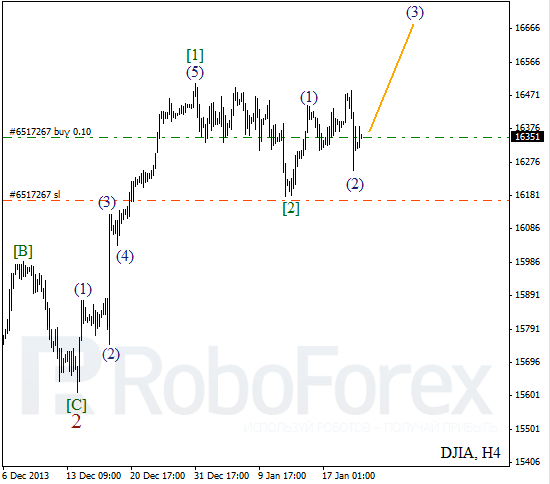
As we can see at the H1 chart, Index completed descending impulse inside wave C. Possibly, right now market is forming initial waves inside wave (3). Critical level is at minimum of initial wave (1).
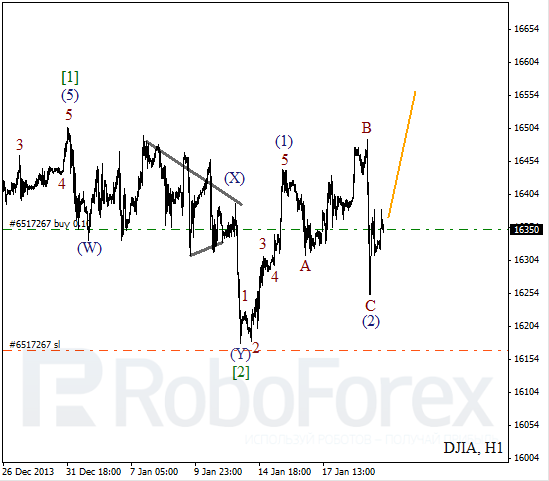
Crude Oil
Correction is taking more time than we expected. Most likely, during the next several days Oil will continue forming wave (2). Forecast is still bearish and implies that instrument may start new descending movement inside the third wave.
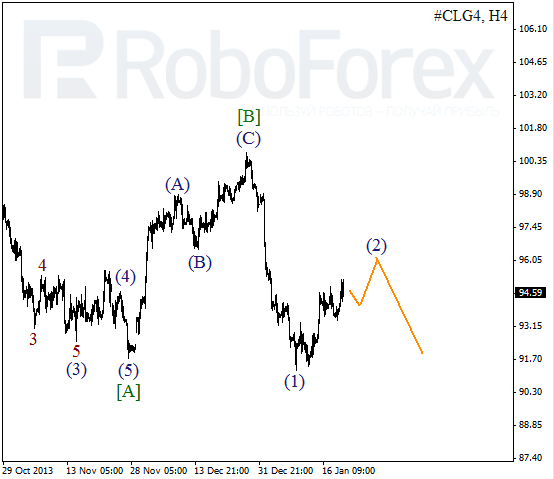
More detailed wave structure is shown on H1 chart. After completing descending impulse inside wave 1, Oil formed five-wave structure inside wave A. In the near term, instrument is expected to start short-term correction inside wave B.
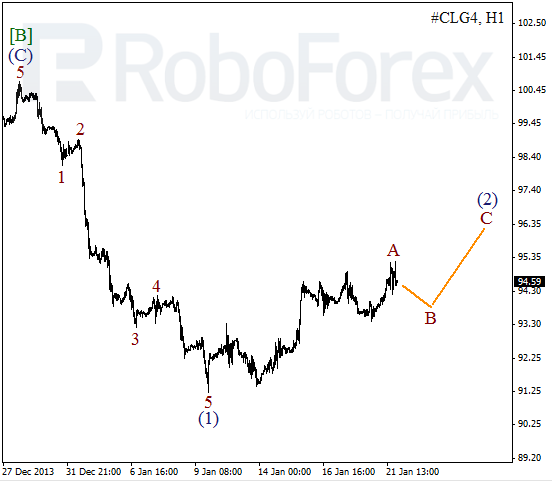
RoboForex Analytical Department
Article By RoboForex.com
Attention!
Forecasts presented in this section only reflect the author’s private opinion and should not be considered as guidance for trading. RoboForex LP bears no responsibility for trading results based on trading recommendations described in these analytical reviews.
Forex Technical Analysis 22.01.2014 (EUR/USD, GBP/USD, USD/CHF, USD/JPY, AUD/USD, GOLD)
Article By RoboForex.com
Analysis for January 22nd, 2014
EUR/USD
Euro continues growing up. We think, today price may return to level of 1.3600 and then fall down towards 1.3550. Later, in our opinion, pair may start forming another ascending structure to reach target at 1.3700.
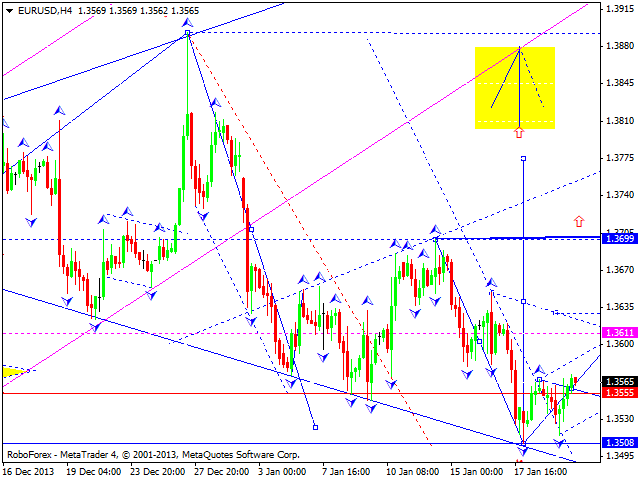
GBP/USD
Pound is still moving inside the fourth wave of bullish wedge pattern. We think, today price may reach level of 1.6500 and then start new descending movement towards level of 1.6255. Later, in our opinion, pair may form reversal structure to continue ascending trend.
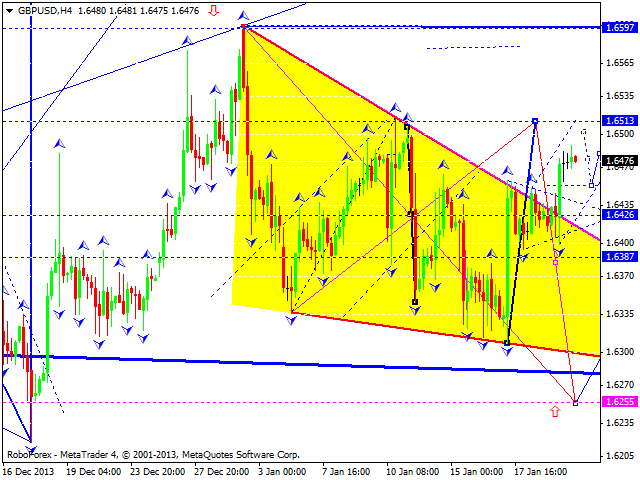
USD/CHF
Franc is still forming head & shoulders reversal pattern. We think, today pair may break ascending channel, fall down to reach level of 0.9000, and then return to 0.9080. Later, in our opinion, pair may continue moving inside descending trend to break minimums and reach level of 0.8300.
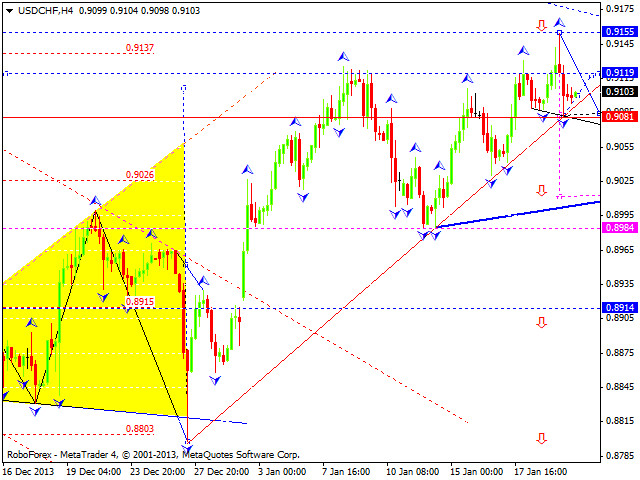
USD/JPY
Yen is still falling down. We think, today price may continue moving downwards to reach level of 103.80. Later, in our opinion, pair may form consolidation channel, break it downwards, and continue falling down towards target at 102.75.
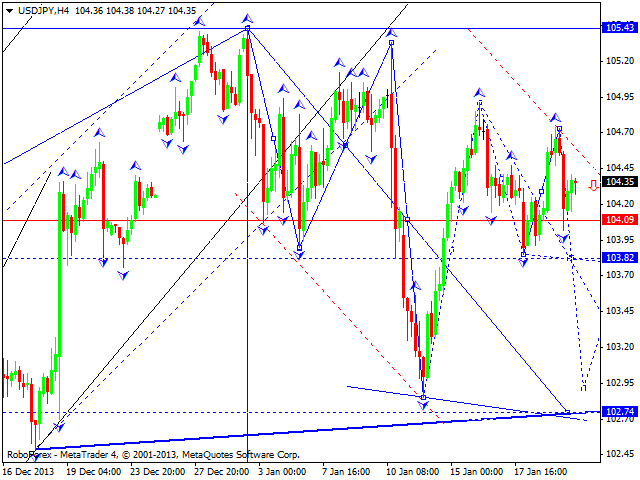
AUD/USD
Australian Dollar is moving towards level of 0.8900; this movement may be considered as correction. After reaching it, pair start forming another descending structure to reach main target at level of 0.8400.
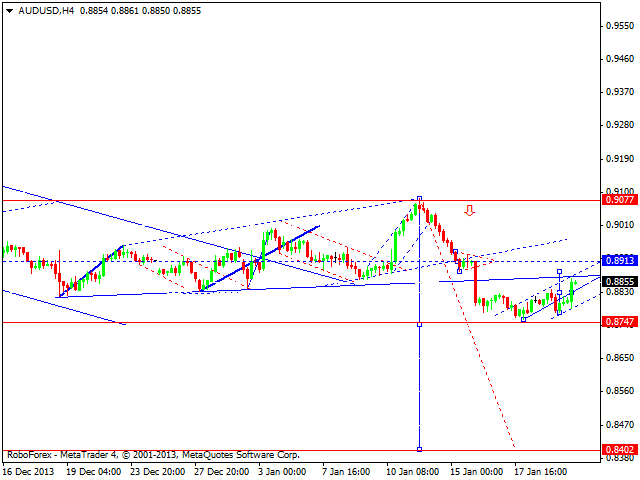
GOLD
Gold is still consolidating inside the fifth ascending wave. We think, today price may break this consolidation channel upwards and continue growing up towards level of 1277. Later, after reaching this level, instrument may start new descending movement towards target at 1230.
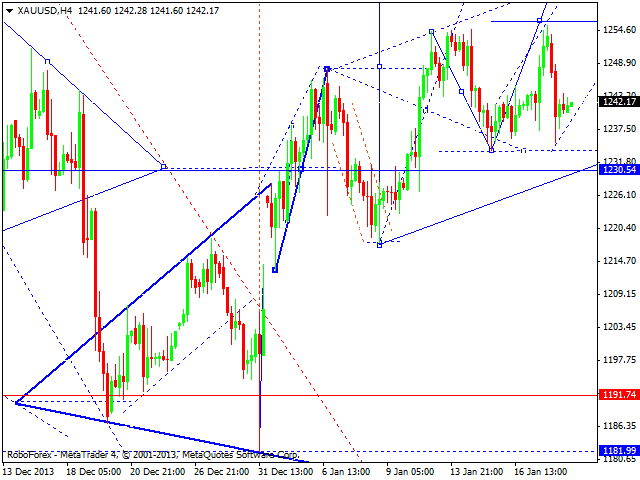
RoboForex Analytical Department
Article By RoboForex.com
Attention!
Forecasts presented in this section only reflect the author’s private opinion and should not be considered as guidance for trading. RoboForex LP bears no responsibility for trading results based on trading recommendations described in these analytical reviews.
Netflix Reports, Are You Ready For High Volatility?
Article by Investazor.com
I continue the earnings reports series with the leading Internet television network, Netflix. In a former article about Netflix, back in November, I said that I expect the stock not to go under the support area from $324 until February and with a couple of days until then the price is around $323, which was a pretty close forecast. Before going into the earnings report specifics, let’s take a look at some statistics.
According to NPD’s “The State of SVOD” report, 32 percent of U.S. households were subscribed to premium-TV channels in August of 2013, compared to 27 percent of U.S. households that subscribed to SVOD services. Netflix remains the clear leader in SVOD (subscription video-on-demand).
Also, Netflix is now available on yet another device. A video service launched an app on TiVo boxes leased by a Swedish pay TV operator, where results from Netflix’s local catalog are now being displayed alongside live TV programming.
Speaking about quarterly earnings, Netflix managed to surprise investors, in a “profitable” way, for the most recent four quarters. On the other hand, on a percentage basis, the surprise factor has been constantly decreasing and it wouldn’t be a shock if these time the surprise to be negative. The consensus EPS for the last quarter of 2013 is $0.66.
The important thing is that Netflix has a “habit” of moving quickly and on major volume post-earnings. Whether the earnings will surprise the market on a positive or a negative note, we’re likely to see some major volatility in Netflix.
On a daily time frame, Netflix post-earnings evolution if the EPS is better than the consensus could be marked by a +10% rise of the share towards the resistance zone from $348-$353, which is also backed up by a 50 day EMA. Conversely, a disappointing EPS could drove the price under the support line from $319 and heading towards the 50.0 or even 61.8 Fibonacci level, with the mention that the 61.8 one has an important psychological meaning because the 200 day EMA is hanging around this level.
The post Netflix Reports, Are You Ready For High Volatility? appeared first on investazor.com.
Gold Price Pushes to 6-Week High as Market Grows More Hopeful
Those who trade gold caused the precious metal to rise to it highest price in six weeks on Jan. 20, as global market participants became more optimistic about the commodity.
Gold futures scheduled for February delivery rose to as much as $1,261.30 per ounce on the Comex division of the New York Mercantile Exchange, according to Investing.com. This represented the highest price for this particular contract since Dec. 11. Later, February gold futures pared these gains, trading at $1,256.00 an ounce. This represented a 0.35 percent increase for the day.
Gold has been rising steadily in 2014
The precious metal has been performing well lately, as thus far in January, it has risen 4.4 percent, Bloomberg reported. In addition to enjoying this return for the month, the precious metal experienced four consecutive weeks of gains. Also, industry data has revealed that lately, market participants increased their wagers that the commodity will continue to rise in price.
Figures provided by the U.S. Commodity Futures Trading Commission indicated that during the week that ended on Jan. 14, the net length position held for gold was 43,277 futures and options, according to the news source. This figure was 7.6 percent higher than the prior period. While short wagers increased by 2.9 percent during the week, bets that the precious metal will appreciate rose by 4.7 percent.
Expert notes importance of Chinese demand
Several factors have been cited as helping to provide upward pressure on the price of the precious metal. Gold is likely benefiting from expectations that Chinese demand for the commodity will probably strengthen in the future, Fawad Razaqzada, who works for Forex.com as a technical analyst, wrote in a note, MarketWatch reported.
The market expert cited the sharp drop in value that the precious metal experienced in 2013, as prices fell roughly 28 percent, according to the news source. He said that seasonal demand for the commodity would be robust, since it has experienced such severe price declines recently. Market participants in the Asian nation have been flocking to the precious metal, and last year, there was an almost 100 percent surge in the number of deliveries made by the Shanghai Gold Exchange, Bloomberg reported.
“There’s a tremendous divide in the gold market,” Jeff Sica, who serves as the president of Sica Wealth Management, told the news source. “Demand for jewelry in China is still relatively strong, and I think it will remain strong. The bears ignore physical demand and think that gold is not relevant when there’s no economic crisis.”
ETF inflows
Another factor that could serve to bolster the price of the precious metal is the robust inflows that exchange-traded products backed by gold have attracted recently, according to the news source. On Jan. 17, the holdings of SPDR Gold Trust, which is the largest ETP backed by the commodity, experienced their sharpest increase since November 2011. Comparatively, on Jan. 16, the investment vehicle held the least amount of gold since 2009. Analysts working for Commerzbank released a note on Jan. 20, in which they noted that the precious metal could move higher in price in the event that the recent strong inflows that gold ETFs have been enjoying are indicative of changing interest in the metal, MarketWatch reported.
“If this turns out to signal a trend reversal, it is likely to lend buoyancy to the gold price,” the analysts wrote in the note, according to the news source. “The high outflows from the gold ETFs observed since the beginning of last year were one major reason for the weak gold price.”
These market experts are not the only ones who believe that gold prices could do well in the near future, as Danny Laidler, who runs the Australia and New Zealand business of ETF Securities, told Reuters that there are higher odds that the metal will appreciate than depreciate.
“A lot of our clients are still holding onto gold as a risk-event hedge,” he told the media outlet. “I think the worst of the outflows is behind us. We think there is a greater potential for modest gains (in gold prices) this year than for a downside risk.”
In the event that the turbulent price performance that the precious metal experienced last year will be followed by a correction in 2014, gold could easily appreciate. In 2013, the commodity had a rough ride, falling into a bear market in April, after having dropped more than 20 percent from its all-time high. This lackluster performance continued for the next few months, and in June, gold plunged below $1,200 per ounce.
The precious metal then managed to enjoy a few months of gains following this recent low. Even after enjoying some appreciation after dropping to an almost three-year low in June, gold finished 2013 down almost 30 percent.
The post Gold Price Pushes to 6-Week High as Market Grows More Hopeful appeared first on | HY Markets Official blog.
Article provided by HY Markets Forex Blog
Crude Oil Trading Causes Commodity to Depreciate amid China Growth Concerns
Crude oil trading resulted in the commodity falling in price on Jan. 20, as global market participants responded to data pointing to lackluster economic conditions in China.
February U.S. crude futures reached $93.70 per barrel during the day on the New York Mercantile Exchange, according to The Associated Press. In addition, March Brent crude contracts trading on the London-based ICE Futures exchange were 20 cents lower at $106.28 a barrel.
It is also important to note that while the price of the commodity fell on Jan. 20, investment managers have recently become less bullish in their predictions for the raw material, according to data provided by London-based exchange ICE Futures Europe and reported by Bloomberg.
Figures provided by the bourse in its Commitments of Traders report revealed that during the week that ended on Jan. 14, combined bets that Brent crude will rise in price dropped by 14 percent, according to the news source. However, even after this decline in bullish wagers, net long positions were still greater than bets that the commodity will fall in value.
Both the decline in price, and also the drop in wagers being made that the commodity will be pushed higher as a result of crude oil trading, were made at a time when there are concerns about China’s demand for the key energy source, Reuters reported.
Concerns about demand in China
Calculations conducted by the media outlet harnessing preliminary government data revealed that in 2013, implied demand for oil increased by a meager 150,000 barrels per day. As a result, this key measure rose only 1.6 percent year-over-year. Such figures may be of interest to those who trade the raw material, since China is the world’s second-largest consumer of oil.
“The long term oil demand trend is certainly not what it used to be,” Alex Yap, who works for Facts Global Energy as an oil analyst, told the news source. “But I think 2014 could be better with new refineries starting and Strategic Petroleum Reserve stockpiling.”
China economic growth slows
In addition to this report on the Asian nation’s demand for the energy source, separate data was released, which helped paint a picture of deteriorating business conditions in China, according to AP. Figures revealed that during the final quarter of last year, gross domestic product grew at an annualized rate of 7.7 percent, which was slower than the prior period.
“The modest Chinese economic data weighed on market sentiment … adding pressure to crude oil prices,” analysts at international derivatives broker Sucden Financial Research wrote in a note to clients, the media outlet reported.
While these particular market experts asserted that the figures released for the Asian nation would help push the price of the commodity lower, not everyone was negative in their interpretation of the data, as Ben Le Brun, who works for OptionsXpress in Sydney as a market analyst, provided a more optimistic view of the figures, according to Reuters.
It is important to note that while China’s GDP grew a bit more slowly during the fourth quarter than it did during the prior three months, the 7.7 percent rate was higher than the 7.6 percent that as predicted by the broader market, the media outlet reported.
“The data is a cause for relief, as it eases some of the fears over the Chinese economy,” he told the news source.
Global supply concerns
Another factor that has been noted as providing downward pressure for oil prices is hopes that the global supply of the energy source could rise soon if key areas such as facilities in Libya start producing once again, according to AP. The production if oil could receive a boost in the event that crucial locations in the Eastern section of the African nation fall into the hands of government officials. Thus far, these key areas have been hindered by rebel activity.
“The prospect of a growing oil supply is continuing to weigh on prices,” major financial services firm Commerzbank wrote in a research note, the media outlet reported. “Any seizure of the oil terminals by force would mean escalating the crisis and make it more difficult – if not impossible – to find any permanent solution to it.”
Global supply could also be bolstered in the event that the removal of economic sanctions allows the Iranian production of oil to operate at its full potential, according to Reuters. During the last 18 months, the amount of the raw material contributed by the Western Asian nation has plunged by more than 50 percent, falling to 1 million barrels per day.
However, the amount of oil supplied by the country could potentially move far higher, at least if the information contained in a United Nations report obtained by the media outlet is accurate. This document indicated that nuclear activity in Iran has ceased for the most part. If the current economic sanctions that were previously imposed because of these activities are lifted, it could have a significant impact on crude oil trading.
The post Crude Oil Trading Causes Commodity to Depreciate amid China Growth Concerns appeared first on | HY Markets Official blog.
Article provided by HY Markets Forex Blog